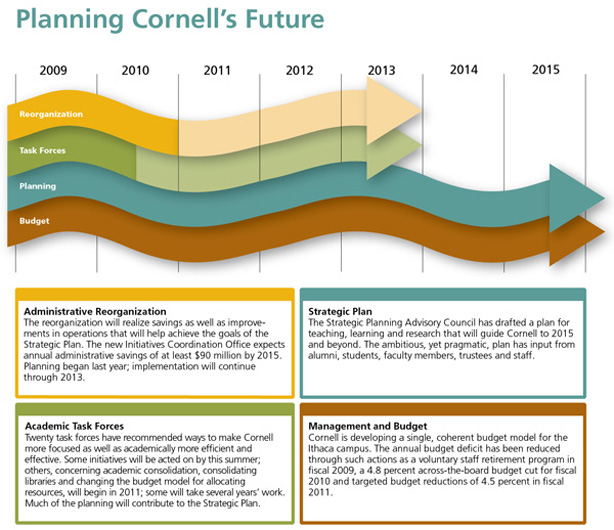COVER STORY

This word cloud image was created by running the text of Cornell's strategic plan (approximately 25,836 words) through a computer program that generates a designed, weighted list; the resulting collage shows the 100 words that appear most often in the 70-plus-page document, sized proportionally. See full image
Aspirations, ambitions, ideas: Historic plan charts university's path to 2015 and beyond
Paul Streeter was as well equipped as anyone at Cornell to detect the first tremors of the Great Recession as they began to vibrate through the university in fall 2008. A soft-spoken administrator, he had spent 22 years at Cornell and that October had been appointed interim vice president for planning and budget. That's when the Wall Street panic "was just starting to mushroom," Streeter recalls. Yet he was as surprised as everyone at how quickly the financial downturn grew into a full-blown crisis.
By January 2009 Cornell's endowment had sunk by 27 percent in just six months. Cornell's $90 million annual structural deficit threatened to surge to $215 million by 2015 if the university didn't stanch the bleeding.
This was all the more shocking because, until then, a strong endowment, philanthropy and state funding had enabled the university to take what it thought were reasonable financial risks, says Streeter, now associate vice president for planning and budget (and who has just been named assistant dean for finance and administration at the College of Veterinary Medicine). "But the recession and everything that happened with it -- the market, the state's cuts, our reliance on philanthropy -- all meant we had put ourselves in a vulnerable spot, and everything crashed at the same time."
All of Cornell's peers have been going through similar turmoil over the past 18 months. It is clear that the financial problems facing Cornell today are common to higher education throughout the United States.
In some sense, the downturn was serendipitous. Cornell has used the crisis as an opportunity to re-envision itself as a reinvented university with streamlined budgeting and a more academically excellent and unified campus that is prepared to be a global model, both academically and operationally, within five years.
At the heart of this restructuring, dubbed "Reimagining Cornell," is a strategic plan, replete with aspirations, ambitions and ideas that will guide the university through its 2015 sesquicentennial and beyond, says Provost Kent Fuchs. "This document is intended to reflect a new reality for higher education in which our aspirations are tied to reality," he says. The financial crisis, he observes, caused the university "to choose which among our goals are most important." It also resulted in a need for "an ongoing assessment of whether the investments we make or decisions we make to change programs are indeed delivering what we had hoped."
The plan states the central issues: Who are we as an institution? Where do we want to go? How can we get there? How will we know if we have succeeded?
These are the questions that the eight faculty members who make up the Strategic Planning Advisory Council (SPAC) asked as they drafted the plan.
The answers should all be predicated, says the plan, on Cornell's long-term aspiration "to be widely recognized as a top-10 research university in the nation and world, and a model university for the interweaving of liberal education and fundamental knowledge with practical education and impact on societal and world problems."
Three overarching themes will help make that aspiration a reality: unity -- treating Cornell as a single entity, rather than a collection of strong colleges; focus -- on strong (or potentially strong) academic programs; and connectivity -- easing the way for students and faculty to cross colleges and programs. From these three themes have emerged central goals of enhancing excellence in the following areas: faculty; education; research, scholarship and creativity; outreach and public engagement; and staff and organizational stewardship. To get there, the plan proposes seven strategic initiatives.
Faculty Renewal
Perhaps the most pressing initiative is to hire the next generation of faculty. The impetus is a striking demographic: 30 percent of Cornell's faculty members are 60 or older; nearly half are 55 and over. "How Cornell does quality-wise will depend to a large extent on how we deal with this faculty renewal problem," notes SPAC chair Edward Lawler, the Martin P. Catherwood Professor of Industrial and Labor Relations.
The plan recommends hiring "rising stars" and funding new faculty positions in strategically important departments before faculty retirements cause a department's luster to fade. It also suggests expanding the dual-career program, making it more desirable for faculty members' spouses or partners to stay in Ithaca.
Breakthrough Programs
Cornell's faculty also will play a key role in the second strategy: to target a few departments to become world leaders. The idea is to ask deans and faculty which departments are on the cusp of breaking into the top ranks worldwide and then hammer out a plan to raise their quality and stature over the next five years.
Teaching Excellence
The third strategy calls for the development of "a culture of teaching excellence." "It's not that we don't have excellent teaching at Cornell. We do," Lawler says. "But we don't across all departments." The solutions? Among them are to identify good models for policies and procedures that support quality teaching; use them as benchmarks; and to consider the quality of teaching as "a significant factor" when allocating resources to departments.
One Cornell
The plan's fourth strategy of creating "one Cornell" means a university that acts as a single entity. "We don't want a top-down enforcement of curriculum, research or administration. But we do want it to be coherent and to be able to leverage the pieces," Fuchs says.
Such a strategy would develop stronger ties among the colleges, perhaps by removing policies that make it difficult for students in one college to take courses in another; making it easier for faculty to have joint appointments across colleges; and creating ways for collaboration to bubble up across disciplines.
Improved Infrastructure
A fifth strategy calls for better infrastructure to support research, scholarship and creativity. That includes libraries and laboratories and how research grants are administered.
Diversity
Cornell has worked for close to half a century to increase the gender, racial, socio-economic and ethnic diversity of its faculty, students and staff. As its sixth strategy, the plan endorses a strong reassertion of this policy. It seeks, for example, to have women and underrepresented minorities comprise a significantly greater proportion of the faculty.
Engage the World
Finally, the plan recommends creation of a more dynamic interface between the university and the world community -- what the plan refers to as "public engagement." The goal is to make it easier for students to take classes geared toward service-learning, to study abroad, to take on internships and to work with local schools. "Land grant is part of our heritage and our DNA, and we will continue to have that," says Fuchs. "But we want to … create within the state of New York, the country and the world an understanding that this engages all of the university. … We shouldn't rely on our traditional ways of doing this."
So, what will Cornell look like in 2015?
That depends on how the university implements the plan.
Although the 70-plus-page document establishes initiatives, sets broad directions for the university and raises important issues for the future, it doesn't provide detailed plans for particular colleges, departments or other campus units. Nor does it propose specific research themes for the next five years.
It wasn't meant to, Lawler points out.
Those issues, and many others, will be hammered out as the university makes its aspirations a reality. That's one reason this strategic plan won't end up on a dusty shelf, unopened and ignored, Lawler says.
"The plan offers a roadmap for moving the university forward but also will require regular if not continual modifications and adjustments.
"A good strategic plan is going to be a living, working document, even after it's finished."
Visit www.cornell.edu/reimagining to read the strategic plan and to see a comprehensive repository of information and documentation about the entire Reimagining Cornell process.
